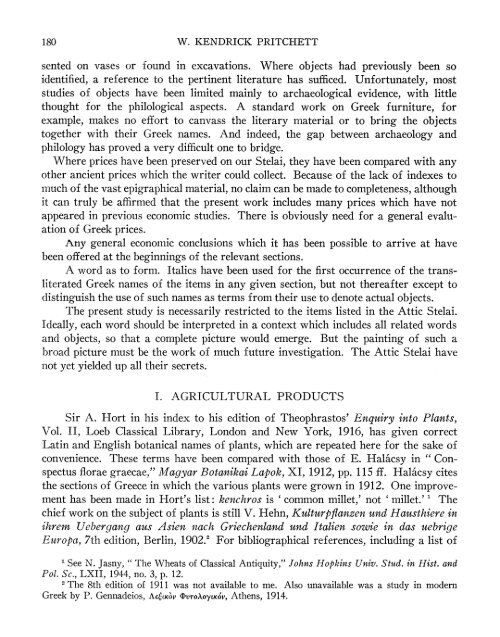the attic stelai - The American School of Classical Studies at Athens
the attic stelai - The American School of Classical Studies at Athens
the attic stelai - The American School of Classical Studies at Athens
Create successful ePaper yourself
Turn your PDF publications into a flip-book with our unique Google optimized e-Paper software.
180 W. KENDRICK PRITCHETT<br />
sented on vases or found in excav<strong>at</strong>ions. Where objects had previously been so<br />
identified, a reference to <strong>the</strong> pertinent liter<strong>at</strong>ure has sufficed. Unfortun<strong>at</strong>ely, most<br />
studies <strong>of</strong> objects have been limited mainly to archaeological evidence, with little<br />
thought for <strong>the</strong> philological aspects. A standard work on Greek furniture, for<br />
example, makes no effort to canvass <strong>the</strong> literary m<strong>at</strong>erial or to bring <strong>the</strong> objects<br />
toge<strong>the</strong>r with <strong>the</strong>ir Greek names. And indeed, <strong>the</strong> gap between archaeology and<br />
philology has proved a very difficult one to bridge.<br />
Where prices have been preserved on our Stelai, <strong>the</strong>y have been compared with any<br />
o<strong>the</strong>r ancient prices which <strong>the</strong> writer could collect. Because <strong>of</strong> <strong>the</strong> lack <strong>of</strong> indexes to<br />
much <strong>of</strong> <strong>the</strong> vast epigraphical m<strong>at</strong>erial, no claim can be made to completeness, although<br />
it can truly be affirmed th<strong>at</strong> <strong>the</strong> present work includes many prices which have not<br />
appeared in previous economic studies. <strong>The</strong>re is obviously need for a general evalu<strong>at</strong>ion<br />
<strong>of</strong> Greek prices.<br />
Any general economic conclusions which it has been possible to arrive <strong>at</strong> have<br />
been <strong>of</strong>fered <strong>at</strong> <strong>the</strong> beginnings <strong>of</strong> <strong>the</strong> relevant sections.<br />
A word as to form. Italics have been used for <strong>the</strong> first occurrence <strong>of</strong> <strong>the</strong> transliter<strong>at</strong>ed<br />
Greek names <strong>of</strong> <strong>the</strong> items in any given section, but not <strong>the</strong>reafter except to<br />
distinguish <strong>the</strong> use <strong>of</strong> such names as terms from <strong>the</strong>ir use to denote actual objects.<br />
<strong>The</strong> present study is necessarily restricted to <strong>the</strong> items listed in <strong>the</strong> Attic Stelai.<br />
Ideally, each word should be interpreted in a context which includes all rel<strong>at</strong>ed words<br />
and objects, so th<strong>at</strong> a complete picture would emerge. But <strong>the</strong> painting <strong>of</strong> such a<br />
broad picture must be <strong>the</strong> work <strong>of</strong> much future investig<strong>at</strong>ion. <strong>The</strong> Attic Stelai have<br />
not yet yielded up all <strong>the</strong>ir secrets.<br />
I. AGRICULT-URAL PRODUCTS<br />
Sir A. Hort in his index to his edition <strong>of</strong> <strong>The</strong>ophrastos' Enquiry into Plants,<br />
Vol. II, Loeb <strong>Classical</strong> Library, London and New York, 1916, has given correct<br />
L<strong>at</strong>in and English botanical names <strong>of</strong> plants, which are repe<strong>at</strong>ed here for <strong>the</strong> sake <strong>of</strong><br />
convenience. <strong>The</strong>se terms have been compared with those <strong>of</strong> E. Halacsy in " Conspectus<br />
florae graecae," Magyar Botanikai Lapok, XI, 1912, pp. 115 ff. Halacsy cites<br />
<strong>the</strong> sections <strong>of</strong> Greece in which <strong>the</strong> various plants were grown in 1912. One improvement<br />
has been made in Hort's list: kenchros is 'common millet,' not 'millet.'" <strong>The</strong><br />
chief work on <strong>the</strong> subject <strong>of</strong> plants is still V. Hehn, Kulturpflanzen und Hausthiere in<br />
ihrem Uebergang aus Asien nach Griechenland und It alien sowie in dais uebrige<br />
Europa, 7th edition, Berlin, 1902.2 For bibliographical references, including a list <strong>of</strong><br />
1 See N. Jasny, " <strong>The</strong> Whe<strong>at</strong>s <strong>of</strong> <strong>Classical</strong> Antiquity," Johns Hopkins Univ. Stud. in Hist. and<br />
Pol. Sc., LXII, 1944, no. 3, p. 12.<br />
2<strong>The</strong> 8th edition <strong>of</strong> 1911 was not available to me. Also unavailable was a study in modern<br />
Greek by P. Gennadeios, AEewLKOV 4VTOxo7tKOv, A<strong>the</strong>ns, 1914.
















